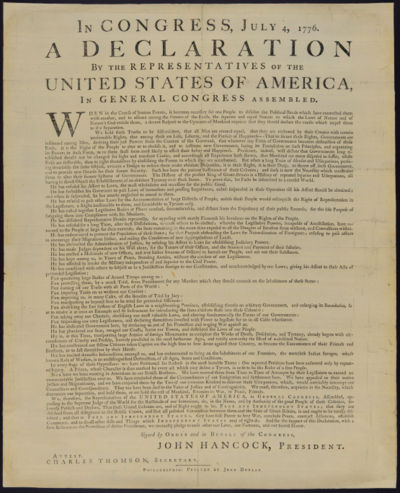U.S. Declaration of Independence
The Declaration of Independence, unanimously approved by the second Continental Congress on July 4, 1776, created a new nation, the "United States of America." It formally "dissolved the connection" between the thirteen states which had acted as the "United Colonies" and Great Britain. July 4 is still celebrated as the nation's birthday.
Public opinion
Sentiment for independence was crystallized by Common Sense, the astonishingly successful pamphlet by Thomas Paine. It sold over 150,000 copies in spring 1776; copies were passed from hand to hand and read aloud at taverns in every colony. General George Washington was especially impressed and he had it read aloud to his soldiers. Paine's forceful argument convinced the majority that that the Empire was a dead weight on American aspirations, and the time was now to become independent. The Loyalists were left almost speechless. Support for the King, which had been fast dwindling away, evaporated after Americans digested Paine's philippic. Not only was liberty at risk under monarchy, Paine said, but so was peace, as monarchs had little else to do but lay "the world in blood and ashes." His key argument was an attack on the possibility of reconciliation. Paine convinced his readers that independence was more likely to bring peace and prosperity than continued subservience to the empire. But Paine drove ahead adding a millennial quality to the colonists' struggle. This was not a revolt over taxation. The survival of liberty and republicanism was at stake, he argued and if the American Revolution succeeded, generations yet unborn would owe a debt of gratitude to their forebearers who struggled to defend—-and expand-—freedom. Paine foresaw an America that would become "an asylum for mankind." Not only would America offer refuge to the world's oppressed, but like a shining beacon, revolutionary America would herald "the birth-day of a new world," the beginning of an epoch in which humankind across the earth could "begin the world over again."[1]
Writing the Declaration
The "Declaration Committee," which included Thomas Jefferson of Virginia, Roger Sherman of Connecticut, Benjamin Franklin of Pennsylvania, Robert R. Livingston of New York, and John Adams of Massachusetts, was appointed by Congress on June 11, 1776, to draft a declaration in anticipation of an expected vote in favor of American independence, which occurred on July 2. [2]
The primary author was Thomas Jefferson, selected by Adams and Franklin because he was the best writer. Early drafts exist dating to June 1776.[3]
Voting was by states and the Declaration was not unanimous on July 4 but became so a little later. On July 4, the New York delegation could not sign since its instructions to do so did not arrive until July 9. The original title referred to Twelve States. Several delegates were opposed at first but later signed.
Signers
There are 56 signatures on the declaration of independence [4]
- Georgia
- North Carolina
- South Carolina
- Massachusetts
- Maryland
- Virginia
- Pennsylvania
- Delaware
- New York
- New Jersey
- New Hampshire
- Massachusetts
- Rhode Island
- Connecticut
Bibliography
- Becker, Carl. The Declaration of Independence: A Study on the History of Political Ideas (1922), online edition
- Ellis, Joseph J., ed. What Did the Declaration Declare? Bedford Books, 1999. 110 pp. online review
- Middlekauff, Robert. The Glorious Cause: The American Revolution, 1763-1789 (2nd ed 2007) general history of the Revolution excerpt and text search
notes
- ↑ John Ferling, Setting the World Ablaze: Washington, Adams, Jefferson, and the American Revolution. (2002) p. 130
- ↑ Declaring Independence: Drafting the Documents. Retrieved on 2007-08-04.
- ↑ Transcription of the Fragment of the Composition Draft of the Declaration of Independence. Retrieved on 2007-08-04.
- ↑ Signers of the Declaration. Retrieved on 2007-08-04.
